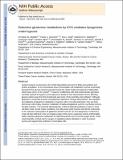| dc.contributor.author | Metallo, Christian M. | |
| dc.contributor.author | Gameiro, Paulo A. | |
| dc.contributor.author | Bell, Eric L. | |
| dc.contributor.author | Yang, Juanjuan | |
| dc.contributor.author | Hiller, Karsten | |
| dc.contributor.author | Jewell, Christopher M. | |
| dc.contributor.author | Vander Heiden, Matthew G. | |
| dc.contributor.author | Iliopoulos, Othon | |
| dc.contributor.author | Stephanopoulos, Gregory | |
| dc.contributor.author | Kelleher, Joanne Keene | |
| dc.contributor.author | Mattaini, Katherine Ruth | |
| dc.contributor.author | Guarente, Leonard Pershing | |
| dc.contributor.author | Johnson, Zachary | |
| dc.contributor.author | Irvine, Darrell J | |
| dc.date.accessioned | 2014-01-24T16:40:09Z | |
| dc.date.available | 2014-01-24T16:40:09Z | |
| dc.date.issued | 2011-11 | |
| dc.date.submitted | 2011-03 | |
| dc.identifier.issn | 0028-0836 | |
| dc.identifier.issn | 1476-4687 | |
| dc.identifier.uri | http://hdl.handle.net/1721.1/84489 | |
| dc.description.abstract | Acetyl coenzyme A (AcCoA) is the central biosynthetic precursor for fatty-acid synthesis and protein acetylation. In the conventional view of mammalian cell metabolism, AcCoA is primarily generated from glucose-derived pyruvate through the citrate shuttle and ATP citrate lyase in the cytosol. However, proliferating cells that exhibit aerobic glycolysis and those exposed to hypoxia convert glucose to lactate at near-stoichiometric levels, directing glucose carbon away from the tricarboxylic acid cycle and fatty-acid synthesis. Although glutamine is consumed at levels exceeding that required for nitrogen biosynthesis, the regulation and use of glutamine metabolism in hypoxic cells is not well understood. Here we show that human cells use reductive metabolism of α-ketoglutarate to synthesize AcCoA for lipid synthesis. This isocitrate dehydrogenase-1 (IDH1)-dependent pathway is active in most cell lines under normal culture conditions, but cells grown under hypoxia rely almost exclusively on the reductive carboxylation of glutamine-derived α-ketoglutarate for de novo lipogenesis. Furthermore, renal cell lines deficient in the von Hippel–Lindau tumour suppressor protein preferentially use reductive glutamine metabolism for lipid biosynthesis even at normal oxygen levels. These results identify a critical role for oxygen in regulating carbon use to produce AcCoA and support lipid synthesis in mammalian cells. | en_US |
| dc.description.sponsorship | National Institutes of Health (U.S.) (Grant R01 DK075850-01) | en_US |
| dc.description.sponsorship | American Cancer Society (Postdoctoral Fellowship) | en_US |
| dc.description.sponsorship | National Institutes of Health (U.S.) | en_US |
| dc.description.sponsorship | Burroughs Wellcome Fund | en_US |
| dc.description.sponsorship | Smith Family Foundation | en_US |
| dc.description.sponsorship | Damon Runyon Cancer Research Foundation | en_US |
| dc.description.sponsorship | National Cancer Institute (U.S.) | en_US |
| dc.language.iso | en_US | |
| dc.publisher | Nature Publishing Group | en_US |
| dc.relation.isversionof | http://dx.doi.org/10.1038/nature10602 | en_US |
| dc.rights | Creative Commons Attribution-Noncommercial-Share Alike 3.0 | en_US |
| dc.rights.uri | http://creativecommons.org/licenses/by-nc-sa/3.0/ | en_US |
| dc.source | PMC | en_US |
| dc.title | Reductive glutamine metabolism by IDH1 mediates lipogenesis under hypoxia | en_US |
| dc.type | Article | en_US |
| dc.identifier.citation | Metallo, Christian M., Paulo A. Gameiro, Eric L. Bell, Katherine R. Mattaini, Juanjuan Yang, Karsten Hiller, Christopher M. Jewell, et al. “Reductive glutamine metabolism by IDH1 mediates lipogenesis under hypoxia.” Nature (November 20, 2011). | en_US |
| dc.contributor.department | Massachusetts Institute of Technology. Department of Biology | en_US |
| dc.contributor.department | Massachusetts Institute of Technology. Department of Chemical Engineering | en_US |
| dc.contributor.department | Massachusetts Institute of Technology. Department of Materials Science and Engineering | en_US |
| dc.contributor.department | Koch Institute for Integrative Cancer Research at MIT | en_US |
| dc.contributor.mitauthor | Metallo, Christian M. | en_US |
| dc.contributor.mitauthor | Gameiro, Paulo A. | en_US |
| dc.contributor.mitauthor | Hiller, Karsten | en_US |
| dc.contributor.mitauthor | Kelleher, Joanne Keene | en_US |
| dc.contributor.mitauthor | Stephanopoulos, Gregory | en_US |
| dc.contributor.mitauthor | Bell, Eric L. | en_US |
| dc.contributor.mitauthor | Mattaini, Katherine Ruth | en_US |
| dc.contributor.mitauthor | Guarente, Leonard Pershing | en_US |
| dc.contributor.mitauthor | Vander Heiden, Matthew G. | en_US |
| dc.contributor.mitauthor | Jewell, Christopher M. | en_US |
| dc.contributor.mitauthor | Johnson, Zachary | en_US |
| dc.contributor.mitauthor | Irvine, Darrell J. | en_US |
| dc.relation.journal | Nature | en_US |
| dc.eprint.version | Author's final manuscript | en_US |
| dc.type.uri | http://purl.org/eprint/type/JournalArticle | en_US |
| eprint.status | http://purl.org/eprint/status/PeerReviewed | en_US |
| dspace.orderedauthors | Metallo, Christian M.; Gameiro, Paulo A.; Bell, Eric L.; Mattaini, Katherine R.; Yang, Juanjuan; Hiller, Karsten; Jewell, Christopher M.; Johnson, Zachary R.; Irvine, Darrell J.; Guarente, Leonard; Kelleher, Joanne K.; Vander Heiden, Matthew G.; Iliopoulos, Othon; Stephanopoulos, Gregory | en_US |
| dc.identifier.orcid | https://orcid.org/0000-0002-6702-4192 | |
| dc.identifier.orcid | https://orcid.org/0000-0003-0046-1360 | |
| dc.identifier.orcid | https://orcid.org/0000-0002-8676-5738 | |
| dc.identifier.orcid | https://orcid.org/0000-0003-4064-2510 | |
| dc.identifier.orcid | https://orcid.org/0000-0001-6909-4568 | |
| mit.license | OPEN_ACCESS_POLICY | en_US |
| mit.metadata.status | Complete | |
